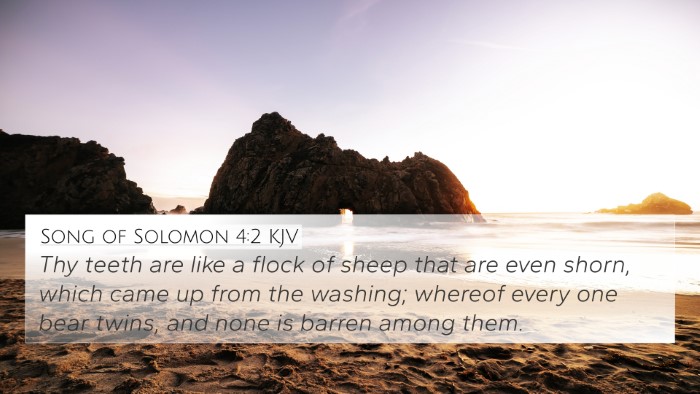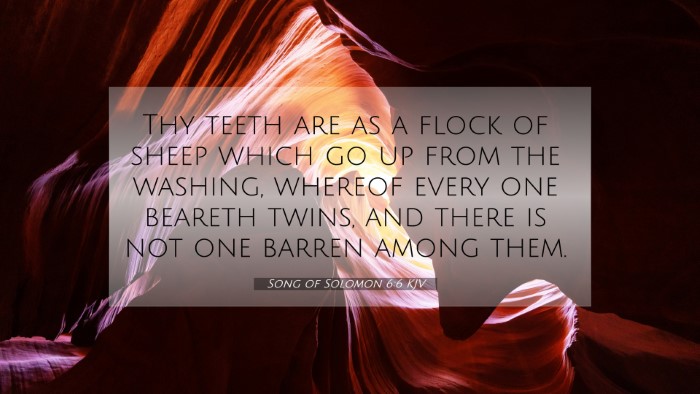Old Testament
Genesis Exodus Leviticus Numbers Deuteronomy Joshua Judges Ruth 1 Samuel 2 Samuel 1 Kings 2 Kings 1 Chronicles 2 Chronicles Ezra Nehemiah Esther Job Psalms Proverbs Ecclesiastes Song of Solomon Isaiah Jeremiah Lamentations Ezekiel Daniel Hosea Joel Amos Obadiah Jonah Micah Nahum Habakkuk Zephaniah Haggai Zechariah MalachiSong of Solomon 6:6 Similar Verses
Song of Solomon 6:6 Cross References
Thy teeth are as a flock of sheep which go up from the washing, whereof every one beareth twins, and there is not one barren among them.
Uncover the Rich Themes and Topics of This Bible Verse
Listed below are the Bible themes associated with Song of Solomon 6:6. We invite you to explore each theme to gain deeper insights into the Scriptures.
Song of Solomon 6:6 Cross Reference Verses
This section features a detailed cross-reference designed to enrich your understanding of the Scriptures. Below, you will find carefully selected verses that echo the themes and teachings related to Song of Solomon 6:6 KJV. Click on any image to explore detailed analyses of related Bible verses and uncover deeper theological insights.

Song of Solomon 4:2 (KJV) »
Thy teeth are like a flock of sheep that are even shorn, which came up from the washing; whereof every one bear twins, and none is barren among them.

Matthew 25:30 (KJV) »
And cast ye the unprofitable servant into outer darkness: there shall be weeping and gnashing of teeth.

Matthew 21:19 (KJV) »
And when he saw a fig tree in the way, he came to it, and found nothing thereon, but leaves only, and said unto it, Let no fruit grow on thee henceforward for ever. And presently the fig tree withered away.
Song of Solomon 6:6 Verse Analysis and Similar Verses
Understanding Song of Solomon 6:6
The verse from the Song of Solomon 6:6 states:
"Thy teeth are like a flock of sheep that are even shorn, which came up from the washing; whereof every one bear twins, and none is barren among them."
This verse imagery creates a vivid picture of beauty and grace, often interpreted within the context of romantic love and admiration. The verse uses pastoral imagery to convey the purity and attractiveness of the beloved's features, specifically highlighting the beauty of her teeth.
Commentary Insights
Various public domain commentaries provide profound insights into this verse:
- Matthew Henry explains that the comparison of teeth to sheep symbolizes purity and cleanliness, reflecting the beloved's charm and the freshness that springs from being shorn.
- Albert Barnes elaborates on the symbolism, noting that the reference to sheep coming from washing signifies not only cleanliness but also fertility and abundance since all the sheep bear twins.
- Adam Clarke contextualizes this metaphoric comparison, suggesting that the beauty of the teeth represents the beloved's overall allure, enhancing the poetic quality of this love song.
Key Themes
The thematic connections found in Song of Solomon 6:6 delineate several key elements:
- Beauty and Attraction: The verse focuses on physical beauty symbolized through natural imagery that resonates with the audience's feelings towards love and affection.
- Purity and Innocence: The description of freshly shorn sheep evokes a sense of purity, parallel to the love relationship being depicted.
- Abundance: The mention of each sheep bearing twins may signify that true love is fruitful and fruitful in various forms—be it physical or emotional.
Cross-References for Deeper Understanding
This verse is deeply interconnected with several other Biblical texts, which enhance its interpretation:
- Proverbs 5:19: "A loving doe, a graceful deer; may her breasts satisfy you always, may you ever be intoxicated with her love." This verse ties into the themes of admiration and physical beauty.
- Song of Solomon 4:1: "How delightful is your love, my sister, my bride! How much better is your love than wine." This earlier verse complements the concept of beauty and love expressed in 6:6.
- Jeremiah 31:12: "They will come and shout for joy on the heights of Zion; they will rejoice in the bounty of the LORD—the grain, the new wine, and the olive oil, the young of the flocks and herds." This encapsulates themes of abundance that parallel the idea of fruitful love.
- 1 Peter 3:3-4: "Your beauty should not come from outward adornment, such as elaborate hairstyles and the wearing of gold jewelry or fine clothes. Rather, it should be that of your inner self, the unfading beauty of a gentle and quiet spirit." This relates to the transient nature of beauty and the importance of inner character.
- Psalms 128:3: "Your wife will be like a fruitful vine within your house; your children will be like olive shoots around your table." Again, elaborating on the concept of fruitful relationships.
- Isaiah 53:2: "He had no beauty or majesty to attract us to him, nothing in his appearance that we should desire him." This verse can be compared to the Song of Solomon, emphasizing different aspects of physical attraction.
- Ecclesiastes 3:11: "He has made everything beautiful in its time." This affirms the significance of beauty in relationships and the divine timing of love.
- Matthew 5:16: "In the same way, let your light shine before others, that they may see your good deeds and glorify your Father in heaven." Relating the beauty of the beloved to the virtue of good works and inner charm.
- Luke 12:27: "Consider how the wild flowers grow. They do not labor or spin. Yet I tell you, not even Solomon in all his splendor was dressed like one of these." This highlights the inherent beauty present in nature, paralleling the beauty in love.
Inter-Biblical Connections
The Song of Solomon stands as a remarkable text in the Bible, with many scholars noting its romantic symbolism that invites inter-Biblical dialogue. By examining the rich imagery and poetic language, one can explore connections to both the Old Testament and New Testament, allowing for an extensive comparative Bible verse analysis.
Tools and Methods for Bible Cross-Referencing
When studying verses like Song of Solomon 6:6, utilizing various tools for Bible cross-referencing enhances understanding:
- Utilize a Bible concordance to locate similar themes and words across the scriptures.
- Engage with a Bible cross-reference guide to find connections that may not be immediately apparent.
- Employ cross-reference Bible study methods to facilitate deeper insight and thematic exploration.
- Consider comprehensive Bible reference resources for in-depth study that connects disparate passages.
Conclusion
Song of Solomon 6:6, while a brief verse, is rich with meaning and imagery, beautifully depicting themes of beauty, purity, and abundance. Through studying this verse alongside its cross-references, readers can uncover deeper understanding and connections between various biblical themes, leading to a more fulfilled exploration of love as portrayed within the scriptures.


